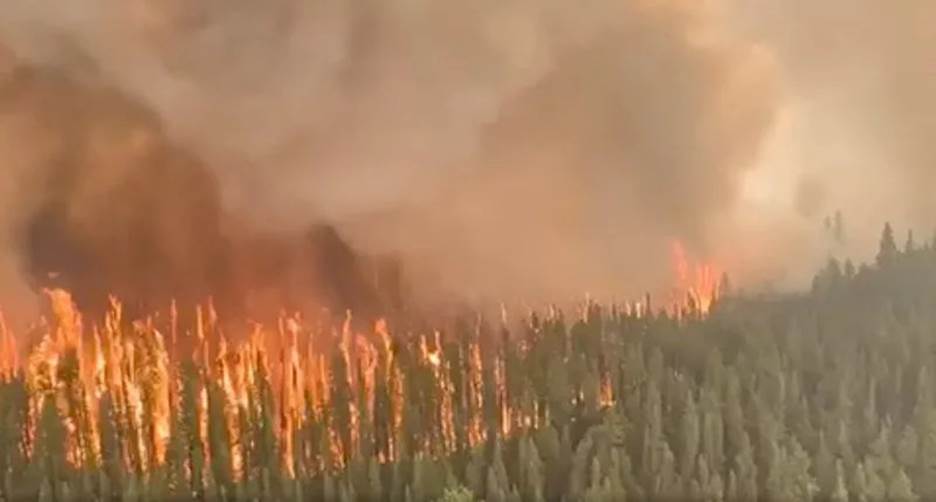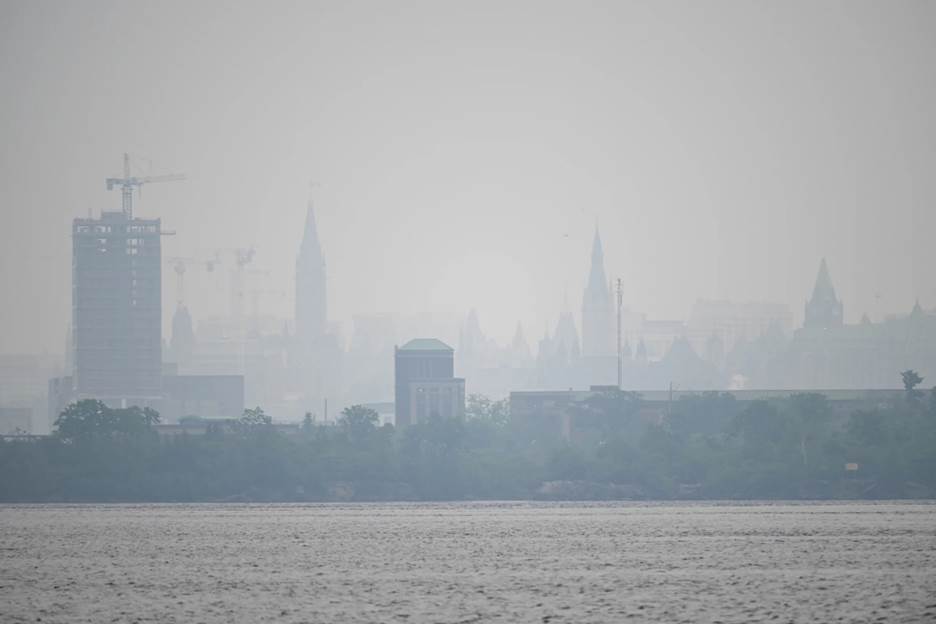
Aerial view of West Kiskatinaw River wildfire in British Columbia
Western Canada Covered in Smoke as Wildfires Loosen Grip on Quebec
By Ismail Shakil
Ottawa
Smoke shrouded Western Canada on Monday as wildfires flared again in the main oil-producing province of Alberta, while firefighters in Quebec doused some of the worst early season blazes, allowing thousands of evacuees to return home.
Canada is enduring its most destructive start to wildfire season, with about 4.8 million hectares (48,000 square kilometers) - an area larger than the Netherlands in western Europe - already burnt.
Forest fires regularly occur in the summer but the scope of the current conflagration - and its early arrival - are unprecedented. On Monday, some 449 fires were burning across Canada, including 219 out of control, according to the Canadian Interagency Forest Fire Center.
"If you look at western Canada, it's completely covered by the smoke and that continues into Tuesday," federal meteorologist Gerald Cheng told reporters on Monday. "The risk for smoke is very high because the winds are really transporting the smoke throughout Alberta today and even into Tuesday."
The fires in Alberta are sending plumes of smoke eastward over prairie provinces Saskatchewan and Manitoba.
TC Energy said two compressor stations and a gas storage facility near wildfires in Edson had to be shut down on Saturday. (Click here to read what health experts say about wildfire smoke.)
Environment Canada's Air Quality Health Index put the Alberta provincial capital Edmonton and oil sands hub Fort McMurray in the "high risk" category.

Smoke from wildfires in Ottawa, Ontario, Canada on Wednesday, June 7, 2023 - Ottawa air quality health index was rated 10+ or "very high risk" by the country's weather agency - Photographer: James Park/Bloomberg
The eastern province of Quebec has seen the number of active fires diminish to about 110 on Monday from nearly 150 last week that sent a veil of smoke over the US East Coast.
Cheng said some rain was in Quebec's forecast on Monday, but not enough in the places with the most active fires.
"On top of that, only showers are in the forecast with thunderstorms, lightning - especially later for the week," Cheng said, noting the risk of lightning igniting new fires.
Nearly 5,000 firefighting personnel are deployed in Alberta, Nova Scotia and Quebec, and Canadian Defense Minister Anita told a briefing on Monday that more army members will be deployed to Edson.
The fires have also forced Canada's forestry industry to shut down sawmills, driving up lumber prices and setting production back for months just as housing construction has slowed due to higher costs and a tight labor market.
According to another story by David Ljunggren, wildfires spread in the western Canadian province of British Columbia on Friday, while in the east, Quebec said it would start efforts to control blazes that have sent smoke billowing across North American cities.
Canada is enduring its worst start to the wildfire season, with 2,392 fires so far this year and 4.4 million hectares (10.9 million acres) burned, according to the Canadian Interagency Forest Fire Centre (CIFFC), roughly 15 times the annual average over the last decade.
The CIFFC reported 424 active fires, of which 230 were out of control. It is unusual for blazes to be burning simultaneously in the east and west, stretching resources and fueling concerns about the consequences of climate change.
Around 2,500 people were told to evacuate the community of Tumbler Ridge in northeastern British Columbia on Thursday. Officials also expanded evacuation orders for the Donnie Creek fire, the second-largest recorded in the province.
A video distributed by the British Columbia fire service showed deserted streets in Tumbler Ridge, while nearby forests were ablaze. Some evacuees are finding shelter in Dawson Creek, a town some 120 km (75 miles) to the northeast.
"It's devastating, it hits you right in the heart ... it's scary, knowing it's this early in the season," Dawson Creek mayor Darcy Dober told the Canadian Broadcasting Corp.
In the eastern province of Quebec, forestry minister Maite Blanchette Vezina said that as extra resources arrived, authorities would be better able to control the fires. Hundreds of firefighters from across the world have flown to Canada.
"This sprint phase is over - now we're in a marathon phase. So in the next days and weeks we will be working to contain those active fires to bring them under control and eventually extinguish them," she told a briefing.
Some rain is expected over Quebec and neighboring Ontario this weekend but it may not be overly helpful, Environment Canada meteorologist Gerald Cheng told an online briefing.
"I caution everyone not to be too hopeful about the rain, because that comes with the risk of thunderstorms ... the precipitation could be very isolated," he said.
Temperatures in parts of British Columbia soared to more than 30 Celsius (86 Fahrenheit) this week, nearly 10 C above the seasonal average. While rain is expected over the weekend there is a risk of lightning strikes.
In the western province of Alberta, more than 3,500 people remain under evacuation orders and heat warnings were in effect over much of the central area.
Poor air quality is expected to persist in cities including Ottawa, Toronto, New York and Washington until Sunday when the wind direction shifts.
While airports in the New York region have been hit by smoke, travel in Canada is not being affected.
"At this time, there have been no major reported impacts to commercial aviation operations due to the wildfires," said Hicham Ayoun, a spokesperson for Transport Canada. – Reuters

